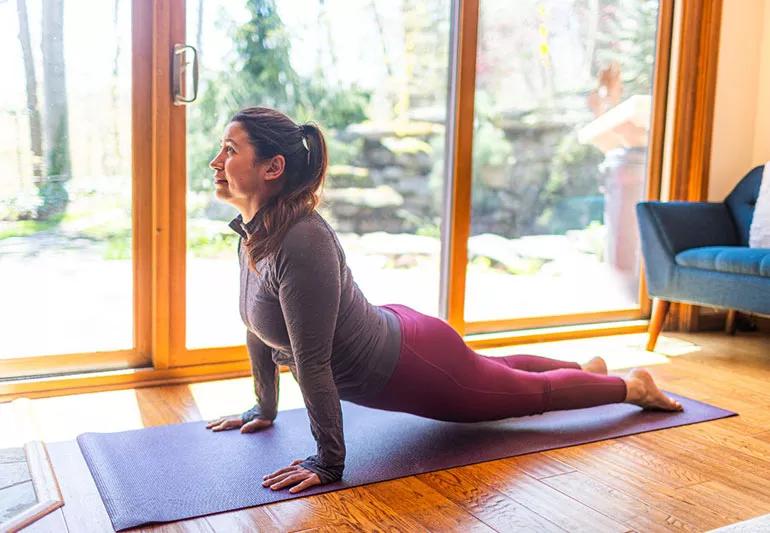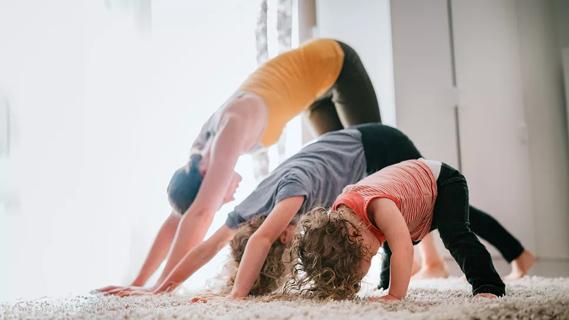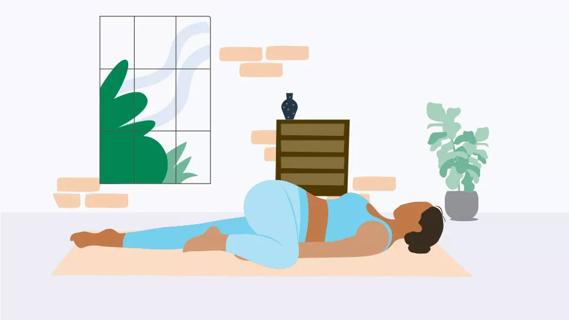Think of it as self-care that you can practice anywhere

Many of us have been married to stress for a very long time.
Advertisement
Cleveland Clinic is a non-profit academic medical center. Advertising on our site helps support our mission. We do not endorse non-Cleveland Clinic products or services. Policy
It clings to us at work, it swirls around us as we manage personal matters, and it even crawls into bed with us and steals nights of restful sleep. We know it’s not good, but we just can’t seem to file those divorce papers. But if we truly want to preserve our mental and physical health, we need to drop that zero and become self-care heroes.
Establishing a home yoga practice is a great way to keep your body and mind at ease. Yes, it can sometimes test your patience, and you might not be able to touch the floor during that first — or 15th session. But the beauty of it is if you keep at it, you’ll eventually loosen the tight grip that stress has on your body.
Stress has been shown to affect the body from head to toe. In addition to muscle tightness, it can be at the root of chronic pain, breathing issues, cardiovascular problems, stomach trouble, anxiety and more.
According to the American Psychological Association, one of the best things that you can do to manage stress is to exercise regularly. If you’re not very active or have mobility limitations, yoga is very adaptable. A common misconception is that you have to be super flexible to do it. You don’t. You also don’t need fancy equipment, a membership to an exclusive studio or clothing with premium price tags. What you will need is a lot of patience, the ability to laugh at yourself from time to time and a willingness to block out your ego.
Advertisement
It’s natural to want to nail every yoga pose or imitate the movements of instructors or social media influencers. Fight that urge to do so. Before you even get on your mat, tell yourself this, “My practice is unique like me and that is perfectly fine.” Why? Because pushing yourself to do what everyone else is doing could lead to frustration — or injury.
“Part of it is just knowing what our body needs and not pushing it,” says yoga therapist and yoga program manager, Judi Bar. “We can’t let our egos get in the way because inevitably, something will happen — we could get hurt or become so sore that we can’t move.”
Pre-pandemic, you could drop in on a few yoga classes to discover the styles that work for you. Many studios have adjusted to accommodate social distancing protocols. If you don’t have the option to drop in or you’re not quite ready for group classes, you can still explore the yoga world virtually.
Get online and research different styles before you start your home practice to discover how they can help your body. Once you have a better understanding, you can check out virtual classes offered by studios or community groups in your area, apps or YouTube videos.
Start off with sessions that were developed for beginners. And don’t be afraid to try videos from different instructors. This will allow you to experience a variety of teaching styles and find one, or a few, that appeal to you.
“So it’s a whole mentality — vetting, looking and watching some of the classes that people present to figure out if they feel comfortable,” says Bar. She adds that the main thing in this process is listening to what your body needs and not getting in deeper than you need to be.
According to Bar, Yoga is not just about physical poses. Mindfully accepting and being patient with our progress is one of the biggest benefits of practicing regularly.
Some of us live for competition. That’s not what yoga is about. Competition, even if it is with yourself, could get you hurt. Bar explains.
“It’s the American way — better, harder, faster competition and that’s totally the opposite of what yoga is. Yoga is about being in the moment. Not competing, not judging but listening to our body. It’s about developing the practice of doing the best you can each day without hurting yourself. Some days are balanced. Some days, we’re not as flexible. And with that overriding acceptance, we learn from ourselves.”
You’ve seen the cool mats and ultra-luxurious yoga pants. And thanks to social media, it might seem like every yogi makes these items part of their practices. But rest assured, these things aren’t essential for a home yoga practice. What’s key is that you’re comfortable and you have a mat and yoga props that meet your needs.
“It’s not necessary to go out and buy a lot of things. You can be creative with what you have at home as long as it feels safe,” says Bar. For example, if you don’t have a yoga strap, you can use a belt, a jump rope, or a long scarf. Don’t have blocks? You can use books or sturdy storage canisters. And for a restorative session, you can use comfy blankets, quilts and pillows. Just pick a quiet place in your home where you can practice and focus on yourself for as long as you need.
Advertisement
When you’re first getting started with your home yoga practice, there’s nothing wrong with following along with an app or a video. But know that you have the option to create a more personal practice once you feel comfortable enough to do so. You don’t have to do a 30- or 60-minute flow-based session every time. You can do a couple of yoga poses and meditate, you can stretch do and breath work or you can meditate the entire time. The ultimate goal is to create a practice that serves you. Whatever you decide, Bar recommends adding a time of recovery at the end of your session.
She shares how a basic flow could go.
Sure, you won’t have an instructor at home to offer assists and check your alignment. But there are some simple things that you can do to protect your body as you practice. Bar offers this advice.
“The basis of alignment is that your body is stacked on top of everything. So, your head should be centered on your shoulders. Your shoulders should be stacked over your hips. Your hips should be lined up with your knees, and your knees should be over your ankles.”
Advertisement
Bar recommends practicing poses in the mirror so you can see your alignment and adjust accordingly. And if you’d feel better with a second opinion, hop on a video chat with an experienced yogi or a yoga teacher in your area to get proper guidance and feedback.
And remember, if something doesn’t feel right, stop. It takes time to learn how to do the more advanced poses. Keep that in mind so you don’t hurt yourself. If you’re determined to try a challenging pose, look for modifications until you know that your body is ready to handle the advanced version.
Advertisement
Learn more about our editorial process.
Advertisement

This gentle yoga stretch supports your spine, strengthens your core and calms your mind

Focus on inhaling and exhaling through 12 steps of a complete sequence

Stand tall and feel grounded with this foundational yoga pose

This transitional and restorative yoga pose provides a full-body stretch

Somatic yoga focuses on the sensation and experience of movement — not striking perfect poses

Balasana, or child’s pose, is a restorative full-body yoga technique

Kids’ yoga can help kiddos become more aware of their physical, mental and emotional selves

This mindful practice is designed to give you mental and physical relaxation

Start having sex about 72 hours before ovulation, then at least every other day during your fertile window

Attachment theory suggests that your earliest relationships shape connections throughout your life

It isn’t a recognized mental health disorder, but research shows that problematic social media use can negatively affect your mental health, self-esteem and sleep